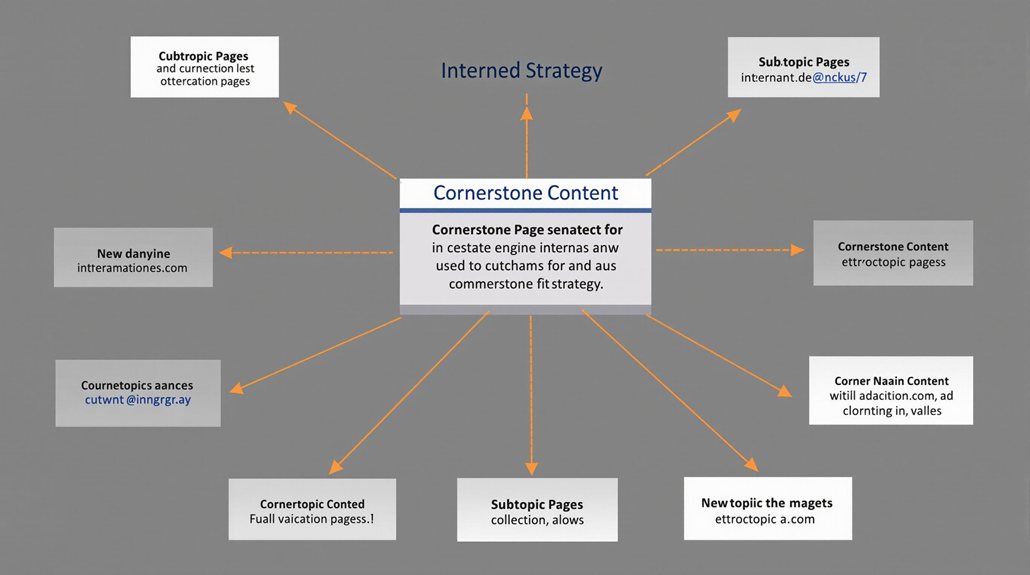Optimize your internal linking strategy for local content by establishing a clear hierarchical structure, highlighting cornerstone pages, integrating contextual links, and revitalizing older content. Utilize anchor links for enhanced navigation, align your links with content marketing goals, and automate the process for scalability. Monitor and adjust your internal linking over time to ensure accessibility, usability, and to position your website as a trusted local authority. There's more to explore when it comes to effective local SEO through internal linking.
Establishing a Hierarchical Structure for Local Content

By establishing a hierarchical structure for your local content, you can create a clear and intuitive navigation system that guides users and search engines through your website. This structure helps position your site as an authority on local topics, improve search engine rankings for location-specific keywords, and enhance the user experience. Key components include pillar pages, subtopic pages, cross-linking, local SEO integration, and content silos. Building content silos around service verticals can help align your content with searcher intent and address their pain points. Strategies like geographic organization, industry-specific silos, and unique selling proposition content can optimize this structure for local search. Proper internal linking practices, such as using descriptive anchor text and maintaining link distribution, are crucial for ensuring your hierarchical structure is effective.
Leveraging Cornerstone Content Pages

As a business focusing on local content, you can leverage cornerstone content pages to strengthen your internal linking strategy and solidify your authority on relevant topics. These foundational pieces provide comprehensive information on core subjects, making them ideal for showcasing your expertise. By strategically linking from supporting articles to cornerstone content, you can signal the importance of these pages to search engines, boosting their rankings and visibility. This approach also enhances the user experience by guiding visitors to authoritative resources. [Regularly updating and promoting your cornerstone content ensures its continued relevance and impact, driving higher-quality traffic and potential leads.] Cornerstone content can also help you tackle high-volume keywords by having supporting blogs with internal links.
Integrating Contextual Links for Local Topics

When creating content for your local business, integrating contextual links can significantly enhance your local SEO efforts. By connecting your local content to other relevant local resources, you can improve search visibility, establish geographic authority, and deliver a better user experience. Contextual links help search engines quickly index new or updated content, and using local keywords in the anchor text further boosts relevance.
| Relevance to Local Search | Improved Geographic Authority | User Experience |
|---|---|---|
| Contextual links enhance relevance by connecting local content to other related local resources, improving search visibility. | Establishing local authority through contextual links helps in higher rankings for local search queries. | Contextual links lead users to valuable local information, improving overall user experience and supporting local SEO efforts. |
Developing strong local content clusters with contextual links is a proven strategy for increasing indexability and strengthening your local authority. [Contextual links also provide valuable signals to search engines about the topical relevance of your content.
Revitalizing Older Local Content With Internal Links
One of the most effective ways to breathe new life into your older local content is by tapping into the power of internal links. This strategy helps enhance user experience, improve site authority, and boost organic traffic. Optimize it Consider these four steps to revitalize your local content:
- Repurpose old content into new formats like videos or infographics.
- Update outdated information to keep content relevant and fresh.
- Optimize slugs to better represent the topic and encourage clicks.
- Use internal linking to highlight your cornerstone local content.
Utilizing Anchor Links for Enhanced Navigation
Anchor links can elevate your local content's navigation and search engine optimization. By crafting descriptive anchor text, you can guide users and search engines to understand your site's content hierarchy. Leveraging these pagelinks effectively will highlight your most valuable local content sections. Additionally, internal links allow you to distribute link equity throughout your site, boosting the visibility of less prominent pages.
Improving Page Navigation
Improving page navigation is often essential for enhancing the user experience on a website. By strategically utilizing anchor links, you can create a more intuitive and efficient browsing experience for your users. Consider these four key benefits:
- Rapid Content Access: Anchor links allow users to quickly jump to specific sections of a page, minimizing the need for endless scrolling.
- Improved Engagement: With easy navigation, users are more likely to explore your content and interact with it for longer periods.
- Enhanced Structure: Anchor links provide a clear content hierarchy, making it simpler for users to understand the organization of your web pages.
- Optimized Readability: By breaking down content into manageable sections, anchor links enhance the overall readability and scanability of your pages.
Boosting SEO With Pagelinks
As we've explored the benefits of improving page navigation, it's now time to understand how you can boost your SEO efforts by leveraging the power of anchor links. Anchor links serve as powerful signals to search engines, helping define content relevance, distribute page authority, and showcase the importance of specific sections. By strategically integrating anchor links, you can enhance your site's visibility in search results, attract more qualified traffic, and improve overall user engagement.
Anchor links help search engines define the content of the page. Implementing a robust anchor link strategy is a crucial step in optimizing your local content for search engines and delivering a seamless user experience.
| SEO Benefits | User Experience | Internal Linking |
|---|---|---|
| Improved Relevance | Reduced Bounce Rates | Pyramid Structure |
| Enhanced Rankings | Faster Information Access | Cornerstone Content |
| SERP Features | Increased Engagement | Anchor Link Variety |
Highlighting Content Sections
Effective content navigation is essential for a seamless user experience. Anchor links enable direct access to specific page sections, enhancing accessibility and readability. When implemented strategically, these links can reduce bounce rates by facilitating quick access to relevant information. Anchor links can also help optimize local content for search engines by making it easier for them to crawl and index the page structure. Consider these four ways to leverage anchor links:
- Use descriptive anchor text to help users and search engines understand the content context.
- Ensure anchor links are fully accessible across devices for an inclusive experience.
- Pair anchor links with a table of contents to further streamline navigation.
- Periodically audit your anchor links to maintain relevance and functionality.
Highlighting Relevant Post Sections on the Homepage
Highlighting relevant post sections on your homepage can draw users' attention to the most valuable local content. Use clear, visually appealing sections to showcase important information. Incorporate prominent call-to-action buttons to encourage further exploration. Utilize relevant images to enhance the appeal of highlighted areas. Search engines rely on links to discover and crawl pages on a website. Craft engaging narratives around the content to make it more relatable. Track user engagement metrics to measure the effectiveness of your highlighting efforts. Organize sections hierarchically, prioritizing the most critical content. Ensure highlighted sections align with user intent and local SEO goals. Regularly update the content to keep it fresh and relevant. Maintain a consistent design style across all highlighted areas.
Optimizing Internal Link Anchor Text for Local SEO
Optimizing your internal link anchor text is a key component of local SEO. By using descriptive, keyword-rich anchor text, you can help search engines better understand the relevance and hierarchy of your local content. Properly structured internal links are essential for search engine crawlers to discover and index website content effectively. Consider these strategies:
- Incorporate location-specific keywords to boost local rankings.
- Use long-tail keywords to target niche queries.
- Ensure anchor text is contextually relevant to the linked page.
- Maintain consistency across your local content pages.
Thoughtful internal linking with optimized anchor text not only improves user experience but also strengthens your local SEO efforts, making it easier for your target audience to find and engage with your local business offerings.
Distributing Link Equity Across Local Content Pages
Distributing link equity effectively across your local content pages is crucial for boosting their visibility and authority. By prioritizing the linkage to your cornerstone content pieces, you can reinforce their status as central hubs and channel link equity to support the performance of your other locally-focused pages. Ensuring topical relevance and a clear site hierarchy are key strategies to maximize the impact of your internal linking structure.
Link Relevance Maximization
When it comes to local content, maximizing the relevance of your internal links is crucial for distributing link equity effectively. Focus on these key principles:
- Anchor Text Relevance: Use descriptive and relevant anchor text to help search engines understand the context of the linked page.
- Content Relationship: Link between topically related pages to pass more link equity.
- Page Hierarchy: Prioritize links to pages closer to your homepage for better crawling and indexing.
- Internal Link Frequency: Maintain a balanced approach to avoid diluting link equity.
Boosting Cornerstone Content
A crucial step in boosting your local content's performance is to prioritize your cornerstone content. This high-authority, comprehensive content should be the focal point of your internal linking strategy. By directing multiple links to your cornerstone pages, you signal their importance to search engines, ensuring they receive the lion's share of your website's link equity.
| Strategies | Benefits |
|---|---|
| Place links to cornerstone content in the main body | These links pass more equity than those in sidebars or footers |
| Use descriptive anchor text | Relevant anchor text helps search engines understand the context |
| Regularly update and interlink cornerstone pages | Maintain freshness and distribute equity across related topics |
Effectively leveraging your cornerstone content is key to optimizing your local SEO efforts.
Maintaining a Cohesive Internal Linking Strategy
Maintaining a cohesive internal linking strategy is crucial for guiding users through your local content and signaling site structure to search engines. To keep your internal links aligned, consider these practices:
- Optimize anchor text to describe the linked content accurately.
- Interlink related local pages to foster topical relevance.
- Distribute link equity by linking to high-priority local pages.
- Regularly audit and update internal links to ensure relevance.
Analyzing User Behavior to Refine Internal Linking
Analyzing user behavior metrics can reveal valuable insights to refine your internal linking strategy. Pay close attention to engagement indicators like bounce rate, session duration, and pages per visit to understand how users interact with your local content. Leverage these insights to optimize the relevance between your pages and the internal links that connect them.
Leverage User Engagement Insights
Delving into user engagement insights can provide invaluable guidance when refining your internal linking strategy. By analyzing metrics like pages per session, bounce rates, and conversion rates, you can identify which links effectively guide users through your content. Consider these four ways to leverage this data:
- Optimize anchor text to provide context and clarity.
- Strategically place links to reduce bounce rates and increase session time.
- A/B test linking structures to determine the most engaging approach.
- Respond to user feedback to ensure links remain relevant and accessible.
Integrating these data-driven insights will help you enhance the user experience and strengthen the effectiveness of your internal linking.
Optimize Content-Link Relevance
When your internal links are tightly aligned with your content, you create a seamless user experience that engages visitors and boosts your site's SEO performance. Contextual connections, keyword integration, and relationship mapping enhance content-link relevance, guiding users through similar topics and strengthening search engine understanding. Distribute link equity effectively to amplify the authority of key pages, and provide clear navigation paths to improve the overall user journey. Leverage Google Analytics to track user behavior, gaining insights to refine your internal linking strategy and optimize for both customer experience and search visibility. By aligning your links with your content, you can drive higher engagement and better rankings.
Incorporating Local Geotargeting in Internal Links
Incorporating local geotargeting into your internal linking strategy can significantly boost your content's visibility and relevance within your target geographic area. By aligning your internal links with local keywords and landmarks, you can optimize your content for higher local search rankings, attracting more qualified leads and potential customers.
To effectively incorporate local geotargeting, consider these strategies:
- Interlink location-specific pages using descriptive anchor text that includes relevant geographic references.
- Leverage internal links to promote your Google Business Profile and other locally-focused content.
- Ensure your site architecture clearly reflects the geographic relevance of your pages.
- Monitor your internal linking performance using analytics to identify opportunities for optimization.
Aligning Internal Links With Content Marketing Goals
Aligning your internal linking strategy with your content marketing goals is key to driving maximum impact. Establishing relevance through internal links signals to search engines the significance of your pages, boosting their authority. Enhancing navigation with well-planned links improves the user experience, while strategically linking top-performing content amplifies its visibility and authority. Fixing broken links and optimizing internal linking reduces bounce rates, further elevating your site's SEO. Incorporate cornerstone, product, and evergreen content into your linking structure, following a hierarchical model that guides both users and crawlers. Descriptive anchor text and contextual placement of links reinforce their value, ensuring your internal linking efforts align seamlessly with your content marketing objectives.
Automating Internal Linking for Scalable Local Content
As local content grows in complexity, automating the internal linking process becomes crucial for maintaining a cohesive, scalable structure. Tools like inLinks and Yoast SEO offer robust features to automate and optimize internal linking for large, localized websites. Here are four key strategies for scalable local internal linking:
- Leverage programmatic SEO to embed links in templates for consistency across new pages.
- Integrate with your CMS to streamline the process of automating internal links in new content.
- Utilize link suggestion tools to identify relevant internal connections based on content analysis.
- Automate link creation in new content to save time and ensure consistent linking patterns, while maintaining manual review for quality.
Monitoring and Adjusting Internal Linking Over Time
Effective monitoring and adjustment of your internal linking strategy is crucial for maintaining a high-performing local content ecosystem. Utilize tools like Google Analytics, SEO suites, and Google Search Console to analyze user behavior, identify site health issues, and track key performance metrics. Regularly audit your internal links, fix broken ones, and redirect outdated content. Align your linking strategy with evolving content and SEO goals, ensuring relevance and link equity distribution. Analyze competitor strategies and conduct A/B tests to continuously refine your approach. Stay vigilant, adapt to changes, and leverage data-driven insights to optimize your internal linking for sustainable local SEO success.
Ensuring Accessibility and Usability Through Internal Links
Crafting an accessible and user-friendly internal linking strategy is crucial for local content. By streamlining your navigation structure, organizing content intuitively, and optimizing the overall user experience, you can empower your audience to effortlessly find and engage with your local offerings. Leveraging best practices for internal linking can significantly enhance the accessibility and usability of your local content.
Streamlined Navigation Structure
A streamlined navigation structure is crucial for ensuring accessibility and usability on your website. This includes:
- Navigational Links: Strategically place these links in your main menus to guide users to your core site sections, like the homepage and product categories.
- Contextual Links: Embed these links within your content to provide supplementary information and improve user engagement.
- Breadcrumbs: Display the current page's position in your site hierarchy to help users understand their location.
- Call-to-Action (CTA) Links: Encourage specific actions, such as signing up or learning more, to drive user conversions.
Intuitive Content Organization
Internal links are the backbone of intuitive content organization, guiding users seamlessly through your website. By strategically placing navigation links, contextual links, and related content, you can enhance the user experience and improve your site's search engine optimization. Organize your content around topic clusters and leverage keyword mapping to ensure visitors find exactly what they're looking for. Don't let new pages become orphans – link them to existing content to aid discoverability. Local content benefits greatly from this approach, helping you strengthen community engagement and local relevance. Maintain consistency, relevance, and optimal link density to create a smooth, intuitive browsing experience that keeps users engaged and coming back.
Optimized User Experience
Seamless navigation lies at the heart of an optimized user experience. By adhering to Web Content Accessibility Guidelines (WCAG), you can ensure your internal links are accessible to users relying on assistive technology. Additionally, offering users the flexibility to open links in new tabs through right-click options demonstrates your commitment to their preferences. To further enhance the mobile experience, optimize internal links for easy browsing without multiple tabs. Finally, utilize descriptive anchor text and maintain consistent link behavior to aid user understanding and navigation, especially for those with cognitive disabilities.
- Ensure WCAG compliance for accessible internal links.
- Provide right-click options to open links in new tabs.
- Optimize internal links for seamless mobile browsing.
- Use descriptive anchor text and maintain consistent link behavior.
